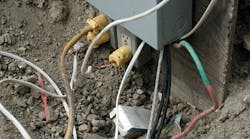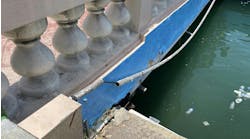How well do you know the Code? Think you can spot violations the original installer either ignored or couldn't identify? Here's your chance to moonlight as an electrical inspector and second-guess someone else's work from the safety of your living room or office. Brian, who has a knack for finding shoddy electrical work, did the dirty work and found this mess. Now it's your turn to identify the violation.
Find the Answer
Isn't this beautiful? In this photo, we see a temporary wiring setup where the installer apparently fabricated some cable assemblies with plug caps for that purpose. As given in 334.10(A)(1), Type NM cable (Romex) may be used "for both exposed and concealed work in normally dry locations except as prohibited by 334.10(3)." Here, the use of Type NM cable outdoors at this temporary wiring installation is a clear violation of 334.10(A)(1), simply because such a location cannot be construed as being "normally dry."
An additional concern about this installation is related to the fact that the installer fabricated these temporary wiring cables with plug caps. Although such fabrication is not prohibited by the rules given for temporary wiring in Art. 590, other rules governing the use of the specific wiring methods must also be satisfied, which was not done in this case. The manner in which the plug caps are installed is questionable, at best. It seems as if this is a violation of 110.12, which requires that "electrical equipment shall be installed in a neat and workmanlike manner." This rule has been interpreted in the past to apply to the assembly of electrical equipment as well as the installation of the equipment.
It should be noted that while not prohibited, use of homemade assemblies such as these should be minimized and employed only as a last resort. There are many different types of commercially available temporary wiring cables that are listed for this specific purpose. And while not prohibited by the NEC, it should be noted that the Occupational Safety and Health Administration (OSHA) would consider the use of homemade temporary wiring cables a violation of the Electrical Design Safety Standard. In general, OSHA requires that where a listed version of any product exists, the listed product must be used. That requirement is more restrictive than the NEC's rules on the use of listed equipment for temporary wiring. The only item specifically required to be listed in Art. 590 is decorative lighting, as given in 590.5.



